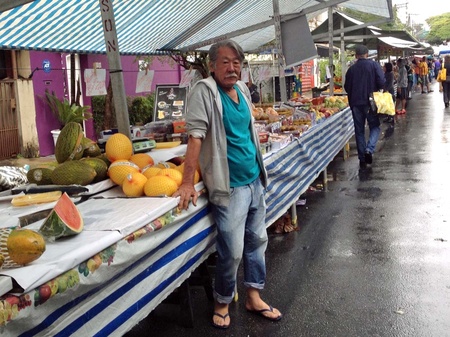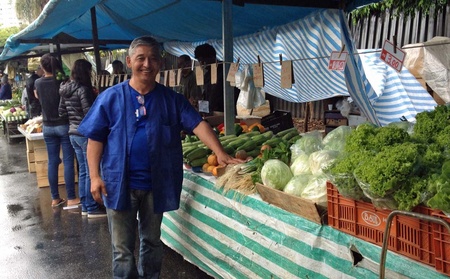One of the pleasant habits that I have cultivated since I was young is attending “ free markets” or “ doing the fair” as they say in São Paulo, the city where I have lived for many years.
The “free market” is a tradition of local culture, as is Carnival, the football game on Sundays, pizza on Saturdays, draft beer on Fridays and the ineffable coffee with milk and bread and butter at the bakery on the corner. Experts say that anyone who isn't enchanted by the charm of a street market doesn't know what it's like to live in this great metropolis.
Exaggerations aside, there are almost 900 fairs in S. Paulo, spread across all neighborhoods. There are more than 12,000 registered stallholders, responsible for more than 16,000 stalls spread across 6 days of the week, in some corner of the city, always from Tuesday to Sunday. It is a commercial practice that emerged in ancient times and was introduced in Brazil since the time of Colonial Brazil. In the Capital of São Paulo, in its 100 years of regulation, it was consolidated in such a way that it ended up becoming a striking feature of São Paulo's popular culture, always maintaining the same format, although some have resented the competition from supermarkets and retailers. They have survived the modernization of times and have maintained their attractiveness, with an estimated audience of around 3 million people, who frequent these open-air markets weekly and stock up on the products sold there.
Open-air markets are responsible for a significant portion of sales of “in natura” products, such as fruits, vegetables, cereals, vegetables, fish, representing a source of 70,000 direct jobs, in addition to representing a true space for interaction and social integration. It is such a democratic activity, where almost everything is allowed, a place where people from all classes mix, without any distinction; Refined ladies and well-dressed executives allow themselves to taste some fruit, while simpler people, in shorts and flip-flops, take advantage of the promotions and bargains at the end of the market. Consumers from different social classes are represented at the open-air market and perhaps this is the true charm of the fairs.
Furthermore, another characteristic that stands out is the massive presence of Nikkei among the tireless and dedicated traders who dedicate themselves to this work, affectionately called “marketers”. According to a survey carried out, in some fairs the presence of Nikkei among stallholders exceeds 50%, giving an oriental touch to the busy business. This percentage became even higher two or three decades ago, when the migration of Japanese descendants living here to Japan began, in search of an alternative job and life, as a result of the serious economic crisis that had hit Brazil, causing the phenomenon called “dekassegui”. Since then, the number of Nikkei stallholders has reduced significantly, having repercussions on the structure and appearance of street markets in São Paulo.
But even so, I have Nikkei marketer friends who have continued to run their stalls for over 30 years, with the difference that their faces already show the rigors of age and hard work, alongside their sons and sons-in-law who now succeed them, in the difficult task of continuing the business.
The fair is a place full of sounds, colors, smells, movement of people. The color of fresh fruits and vegetables is eye-catching and the characteristic smell of each one stimulates the palate. Marketers shout, proclaiming the quality of their products and guaranteeing that their price is the best at the fair. People walk around, examine, haggle or simply go for a walk, “just to look”. Others already have their favorite stalls and know long-time vendors who, at times, seem more like friends than customers.
In these places, the word is still worth more than the bar code, because thanks to the shout of the stallholder or the haggling of customers, open-air markets are surviving the advance of supermarkets. According to reports from some stallholders, half of consumers come looking for price and fresh produce and the other half come to the fair because they like to talk. Amidst the hustle and bustle, shouts can be heard resounding throughout the room: “ Customer, come and try the best pineapple at the market, as sweet as a girl’s kiss!”; “ D. Maria, vegetables are cheaper here; we have lettuce, watercress, cabbage, beetroot and carrots to make that salad!” . In another stall, a young man adds: “pretty girls here don’t pay, but they don’t take anything either!”
Perhaps this is the great competitive advantage of open-air markets in relation to supermarkets, since it is unthinkable for a supermarket employee to approach and sell fruit and vegetables by shouting, in addition to the fact that street vendors can increasingly strengthen their relationship with their clientele through in order to try to make her faithful. It is the possibility of wonderful human contact between customers and stallholders, something unlikely to happen in the cold and impersonal environment of hypermarkets and the like.
In many stalls you can see that the people working are all from the same family. And this detail is confirmed at most fairs. Just walk through any of the city's fairs and you'll find couples, parents and children working at the same stall. According to recent statistics, 60% are men, 40% women, with ages ranging from 35 to 65 years. And, while on the one hand there are few young people up to 25 years old, there is a large participation of elderly stallholders, between 66 and 90 years old. In the middle of all this there are street vendors, with trays mounted on top of crates or simply with cardboard laid out on the ground, who take advantage of the fair to try to sell less noble products. There are boys who offer to help people carry bags. In short, a perfectly organized and democratic “mess”, where everything seems to work at the right time and in the right place.
For those who observe from the outside, the fair resembles a theater full of characters, each with their own life story full of ups and downs, sacrifice and hope, but all aware of the importance of their role within the supply structure of the fair. city, with fresh products and fair prices.
As my friend Washington, a well-educated Nisei, who is so friendly, seems to be friends with almost all the stallholders in his neighborhood, rightly said: “ the stallholders are nice, they have a loving relationship with us. They give us much more attention than we would get in a supermarket!” A statement that is confirmed by stallholder Eduardo Makino, also Nisei, stating that the relationship is reciprocal: “ the customer is a friend. We have several customers like Seu Washington, who has been shopping at our stall for over 20 years. In the end, we ended up getting to know the whole family and their purchasing needs and that’s why we left everything separate!” Ultimately, a relationship of trust and friendship is created that makes the “free market” have this appeal and charm, despite the strong competition from aggressive and powerful supermarkets.
And, as a final and decisive argument: who can resist the invitation to taste at the fair that cheese, meat or 20 other flavors that are offered at the stalls, accompanied by that tasty sugarcane juice with lemon or pineapple, chilled, taken just in time?" It's impossible to miss a program like this, don't you think?
© 2017 Katsuo Higuchi









